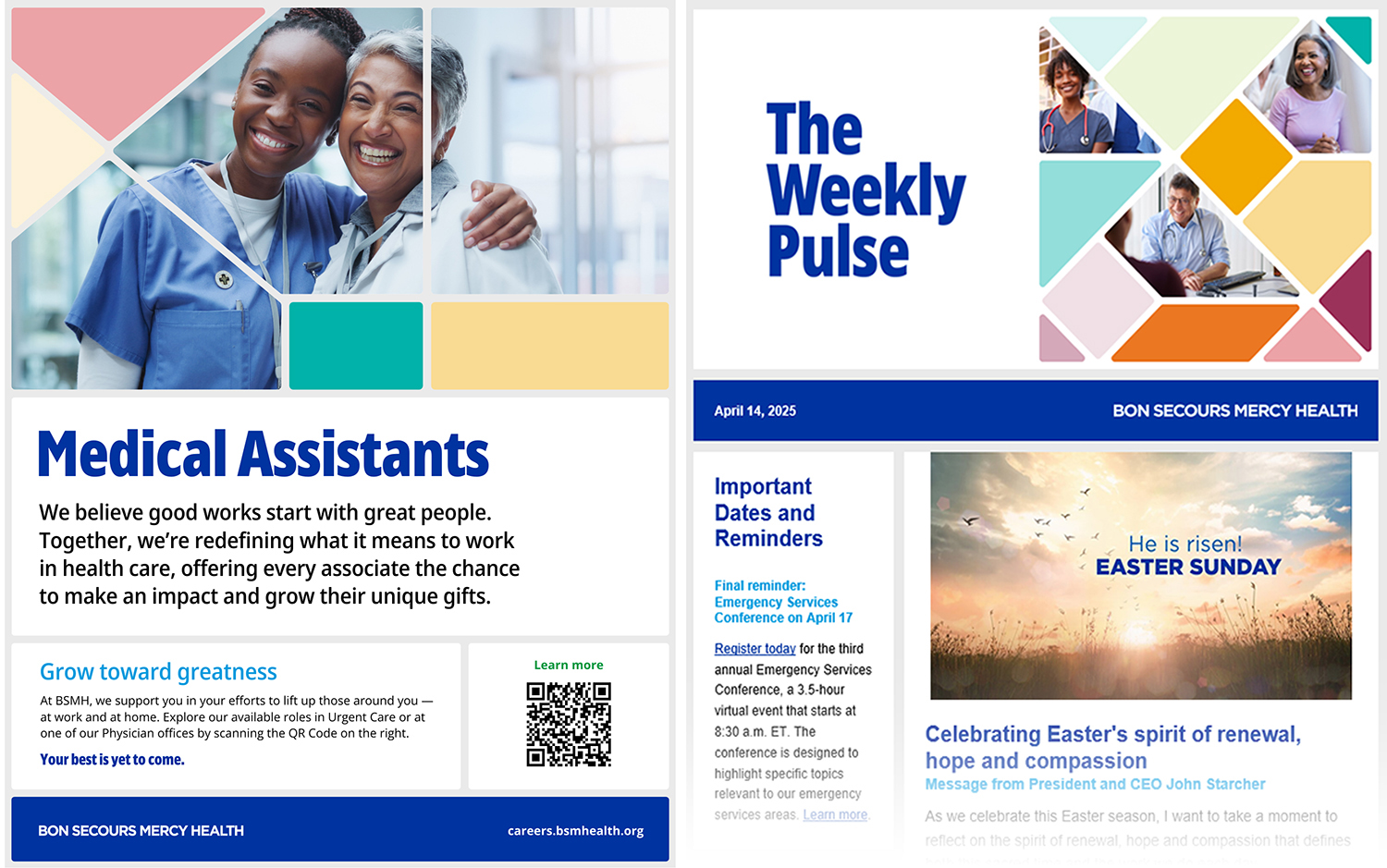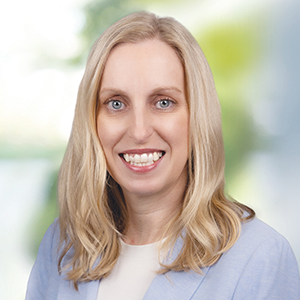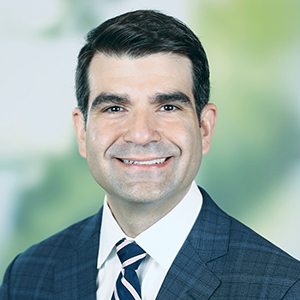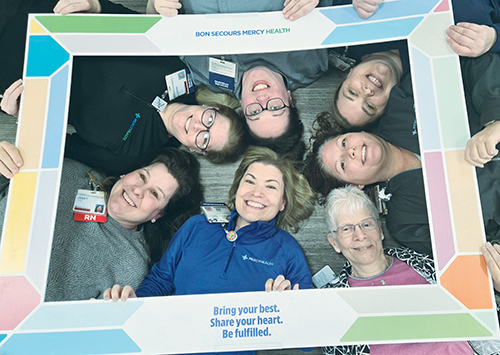

This spring, Bon Secours Mercy Health launched a new employer brand to honor and celebrate its nearly 60,000 associates. The health system also wanted the brand to appeal to prospective associates.
The tagline is "Bring your best. Share your heart. Be fulfilled." The brand is built on Bon Secours Mercy Health's pillars of mission, growth and flexibility and promises to employees: "We'll do good together, we'll grow your gifts and we'll champion you."
Used in employee emails, internal newsletters, recruiting and onboarding materials, some social media channels, and promotional items such as water bottles and notebooks, the visuals for the brand include a design with geometric shapes meant to evoke the pieces of a stained-glass window. Associates can customize colors of the design to use as background screens for virtual meetings.
In the coming months, Bon Secours Mercy Health leaders will measure the brand's impact with surveys and other data.
Catholic Health World spoke with Erin Lickliter, vice president of associate communications, and Allan Calonge, chief people officer, core operations, about the brand, why they wanted to create it, and what they hope it will accomplish. Their answers have been edited for length and clarity.

Why and how did this start?
Lickliter: We probably started almost two years ago. Our human resources team started work around an associate value proposition. As you probably heard from other health care systems and just employers in general, competing for talent is tough. One of the things that we kept talking about was there was a real opportunity for us to narrow the focus on what we really stood for, to really understand what was important to our associates, what was important to candidates. Then we can go back and say, Do we have the right programs? Are we building out the right initiatives, policies, things like that, to really focus on the areas that are most important to our associates and potential candidates?
Calonge: We undertook a pretty lengthy time, probably about 18 months, for study and analysis. We did a lot of internal and external analysis. When we got to the end of this, we figured out the three areas of distinctiveness. One we've done really well for a long time, which is our mission. But two others were growth and flexibility. Folks want to grow. They want to see that clear career progression and to provide for their families. They wanted flexibility within work: shifts, benefits, how they can take time off or care for a newborn or adopted baby.
We started to create programs that spoke to these different areas. But at the same time, in partnership with our marketing and communications team, we said, OK, we're going to build good meat-and-potato programs, but how are we going to make this food look really good? What is the icing on the cake, so to speak? We felt that the expression of it needed to be pronounced.
Tell me about the geometric design.
Calonge: It's based off of stained-glass windows. And so that inspiration was a pretty subliminal acknowledgement of our mission and our Catholic heritage. It speaks to the uniqueness of our associates. We're a very inclusive environment. We celebrate the dignity of all our associates. And we felt that this pattern not only celebrated the women religious who founded us but also speaks to just the uniqueness of who we are and our coming together.
Lickliter: What we also heard loud and clear from our associates, especially when it came to the colors, is they really want to feel the joy and warmth that they feel in their jobs. We have a really bright color palette that allows us to do some eclectic color groupings. It's the sum of parts that makes the most successful team, rather than just the individual piece. So, when you think about stained glass, stained glass is beautiful in its entirety. If you saw one piece, it's nice, but it's so much better when you have everything around it. And that's one of the things that we talked about with our associates, and what they felt too about the power of a team and working with a team. We felt like the stained-glass representation really helped bring that to life as well.
What do you hope this new branding will accomplish?
Lickliter: We want people to feel proud of where they work, which we also know drives loyalty. Ultimately, it's less expensive and easier to keep talent. We do hope that this connects people together. It reminds them that we are the organization that they chose to work for. That's who we are, and they can have the best experience that they want to have here, but retention is really top of mind for us. We've seen some great strides in improving retention since COVID, especially in our nursing turnover, and so having this continues to add that focus on our associates.

As we've been introducing it, we've done a lot of webinars and in-person meetings, talking to people about what it means and why we're doing it. And what I've heard repeatedly is, "I'm so glad we're doing this." They want us to focus as much on their experience as the patient experience, and we know that if our associates feel cared for and supported, then that's the experience that they're going to deliver for our patients.
Calonge: The thing that we saw in our research was that there was a lot of homogeny, a lot of sameness in the way that employers, especially health care employers, are marketing to candidates. You always have the picture of the nurse, or the doctor with the stethoscope, and just some static font and static color, static typography. But what we are trying to do is just be more distinctive and stand out.
Also, this world is so crazy right now. There's a lot of trouble, there's a lot of angst, and so for us to be a bastion of mission and purpose has been really helpful in many of our markets. People tell us that overwhelmingly, in our associate experience survey, affinity to Bon Secours Mercy Health, their desire and willingness to recommend it as a place to work or a place for care has been bolstered by our mission. We feel like this brand helps us to convey that to the marketplace. That's what we're trying to do to counteract those challenges.
Do you have advice for other systems who might want to do this?
Calonge: I think you just got to start by understanding the essence of who you are. I think for Catholic health systems, that would be much easier than nondenominational nonprofits. It's so easy for us. When you have Jesus Christ in your mission statement, it's pretty easy. But I think for any health system, you just need to understand who you are. What makes you tick? What is your purpose? Certainly, patient care, caring for your communities is going to be a universal theme. But I think you need to also lay the framework for perception and awareness and analytics of your workforce. What's driving exits or terminations? How are leaders behaving? How are they engaging? What influences all sorts of associate behavior?
Then number two: What do you do to be distinctive? What are the two or three things that you can anchor to that? Then go through a really intentional navel-gazing to say, How are we going to express that value proposition? What do our sponsors and board think? What do our community stakeholders think about it? And then, put something out that's relevant, that's catchy, that's vibrant, and you have what I think we have right now.
